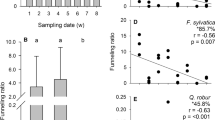Lichen community composition on acid-barked trees has been shown to respond to increasing atmospheric ammonia (NH3) concentrations by loss of acidophyte species and an increase in nitrophyte species. A simple method of sampling selected acidophyte and nitrophyte lichens on trunks and twigs of trees in the vicinity of ammonia monitoring sites across the UK allowed us to test the correlation of lichen communities with ammonia concentrations across the climatic and vegetation zones of the UK.
Sites were selected and field staff from the conservation and regulatory agencies introduced to standard lichen sampling and identification techniques at a workshop co-organised by NHM and CEH Edinburgh. LAN (Lichen Acidophyte Nitrophyte) values were calculated for all sites, based on the frequency of acidophyte and nitrophyte macrolichens on trunks and twigs. Bark samples from trunk and twig were collected and surface bark pH measured in the lab, to test the correlation of acidophyte and nitrophyte communities with bark pH.
Access this chapter
Tax calculation will be finalised at checkout
Purchases are for personal use only
Preview
Unable to display preview. Download preview PDF.
Similar content being viewed by others
References
Asta J.,Erhardt W., Ferretti M., Fornasier F., Kirschbaum U., Nimis P.L., Purvis O.W., Pirintsos, S. Scheidegger C., van Haluwyn C., Wirth V. (2002) Map** lichen diversity as an indicator of environmental quality. In: Nimis P.L., Scheidegger C., Wolseley P.A. (eds.) Monitoring with Lichens — Monitoring Lichens. Nato Science Series. IV. Earth and Environmental Sciences, Kluwer, Dordrecht, The Netherlands, 273–279.
Hawksworth D.L., McManus P.M. (1989) Lichen recolonization in London under conditions of rapidly falling sulphur dioxide levels, and the concept of zone skip**. Botanical Journal of the Linnean Society 100(2): 99–109.
Hawksworth D.L., Rose F. (1970) Qualitative scale for estimating sulphur dioxide air pollution in England and Wales using epiph ytic lichens. Nature 227: 145–148.
Kermit T., Gauslaa Y. (2001) The vertical gradient of bark pH of twigs and macrolichens in a Picea abies canopy not affected by acid rain. Lichenologist 33: 353–359.
Leith I.D., van Dijk N., Pitcairn C.E.R., Wolseley P.A., Whitfield C.P., Sutton M.A. (2005) Biomonitoring methods for assessing the impacts of nitrogen pollution: refinement and testing. JNCC Report No. 386, Peterborough, UK.
Nimis P.L., Castello M., Perotti M. (1990) Lichens as biomonitors of sulphur dioxide pollution in La Spezia (Northern Italy). Lichenologist 22: 333–344.
Sutton M.A., Pitcairn C.E.R., Leith I.D., van Dijk N., Tang Y.S., Skiba U., Smart S., Mitchell R., Wolseley P., James P., Purvis W., Fowler D. (2004) Bioindicator and biomonitoring methods for assessing the effects of atmospheric nitrogen on statutory nature conservation sites. In: Sutton M.A., Pitcairn C.E.R., Whitfield C.P., JNCC Report No: 356, Peterborough, UK.
Sutton M.A., Leith I.D., Pitcairn C.E.R., van Dijk N., Tang Y.S., Sheppard L.J., Dragosits U., Fowler D., James P.W., Wolseley, P.A. (2005) Exposure of ecosystems to atmospheric ammonia in the UK and the development of practical indicator methods. In: Lambley P., Wolseley P.A. (eds.) Lichens in a changing pollution environment. English Nature Research Report 525: 51–62.
van Dobben H.F. (1996) Decline and recovery of epiphytic lichens in an agricultural area in The Netherlands (1900–1988). Nova Hedwigia 62(3–4): 477–485.
van Herk C.M. (1999) Map** of ammonia pollution with epiphytic lichens in the Netherlands. Lichenologist 31: 9–20.
van Herk C.M. (2001) Bark pH and susceptibility to toxic air pollutants as independent causes of changes in epiphytic lichen composition in space and time. Lichenologist 33: 419–441.
van Herk C.M., Mathijssen-Spiekman E.A.M., de Zwart D. (2003) Long distance nitrogen air pollution effects on lichens in Europe. Lichenologist 35: 347–359.
VDI (2005) Biological measurement procedures for determining and evaluating the effects of ambient air pollutants on lichens (bio-indication) — map** the diversity of epiphytic lichens as indicators of air quality. VDI Verein Deutscher Ingenieure (The Association of Engineers),Kommission Reinhaltung der Luft im VDI und DIN — Normenausschuss KRdL (Commission
on Air Pollution Prevention of VDI and DIN — Standards Committee) 3957, Part 13, Berlin. http://www.vdi.de/vdi/presse/mitteilungen_details/index.php?ID=1015947
Wolseley P.A., Pryor K.V. (1999) The potential of epiphytic twig communities on Quercus petraea in a welsh woodland site (Tycanol) for evaluating environmental changes. Lichenologist 31: 41–61.
Wolseley P.A., James P.W., Theobald M.R., Sutton M.A. (2006) Detecting changes in epiphytic lichen communities at sites affected by atmospheric ammonia from agricultural sources. Lichenologist 38: 161–176.
Wolseley P.A., Leith I., van Dijk N., Sutton M. (2007) Macrolichens on twigs and trunks as indicators of ammonia concentrations across the UK — a practical method. In: 20th Task Force Meeting of the ICP Vegetation: Programme, Abstracts (Dubna, March 5–9, 2007). Dubna: JINR: 73 [abstract].
Author information
Authors and Affiliations
Editor information
Editors and Affiliations
Rights and permissions
Copyright information
© 2009 Springer Science + Business Media B.V.
About this chapter
Cite this chapter
Wolseley, P.A., Leith, I.D., van Dijk, N., Sutton, M.A. (2009). Macrolichens on Twigs and Trunks as Indicators of Ammonia Concentrations Across the UK — a Practical Method. In: Sutton, M.A., Reis, S., Baker, S.M. (eds) Atmospheric Ammonia. Springer, Dordrecht. https://doi.org/10.1007/978-1-4020-9121-6_9
Download citation
DOI: https://doi.org/10.1007/978-1-4020-9121-6_9
Publisher Name: Springer, Dordrecht
Print ISBN: 978-1-4020-9120-9
Online ISBN: 978-1-4020-9121-6
eBook Packages: Earth and Environmental ScienceEarth and Environmental Science (R0)




